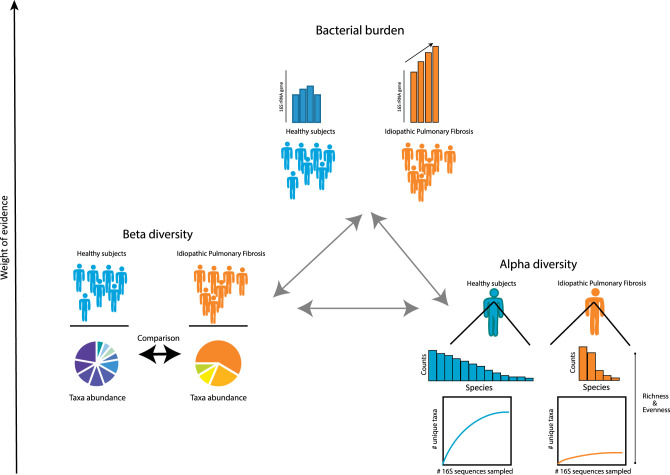Fig. 2.
Features of the lung microbiome in health and idiopathic pulmonary fibrosis (IPF). Graphical representation of the key features of the lung microbiome in healthy subjects and patients with IPF. The weight of evidence to date supports associations between bacterial burden (quantity of 16S rRNA gene counts by PCR) within the lung and clinical outcomes. An increased bacterial burden may result in increased abundance of all bacteria present (without a change in alpha diversity) or increases in certain bacteria and loss of others (with or without changes in alpha diversity). Common measures of alpha diversity include Shannon diversity index, Simpson index, and rarefaction curves. The Shannon diversity index measures the number of local species present and the inequality between species counts/abundance. Rarefaction curves involve the calculation of richness by plotting curves where the number of unique species identified serves as a function of increasing numbers of sequences sampled. In addition, an increase in bacterial burden may or may not result in changes in beta diversity (or the compositional heterogeneity) of bacterial communities present between subjects or samples (i.e., comparison of lung bacterial communities between healthy subjects and patients with IPF). A common measure of beta diversity includes the Bray-Curtis dissimilarity index (comparison of species between two or more samples, where a score of 0 means communities in samples are identical in species presence and abundances and a score of 1 means samples have completely different species abundances). Other measures of beta diversity include the Jaccard distance and UniFrac. In comparisons of lung microbiota in patients with IPF and healthy controls, notable differences are seen in beta diversity and alpha diversity, with lower alpha diversity in patients with IPF (see Ref. 28). Furthermore, in IPF, increasing bacterial burden is associated with a reduction in alpha diversity supporting the gain and/or loss of certain taxa within the lung microbiome (see Ref. 33).

